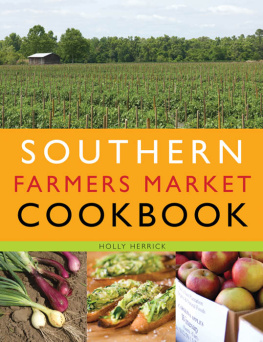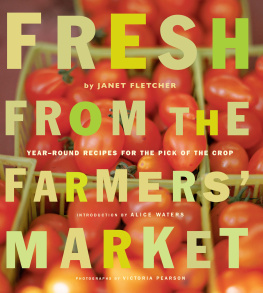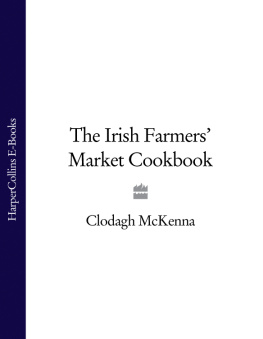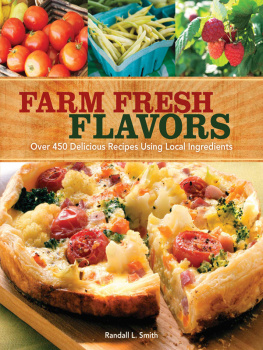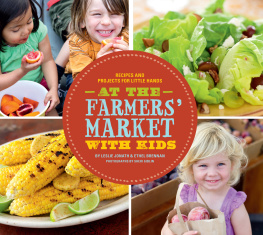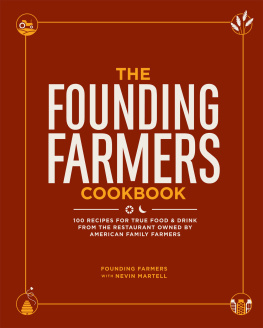All rights reserved. No part of this book may be reproduced by any means whatsoever without written permission from the publisher, except brief portions quoted for purpose of review.
1. Cookery (Natural foods) 2. Farmers markets. 3. Cookery, AmericanSouthern style. I. Title.
Preface
The seeds for this book were probably sown thirty-five years ago when I was a little girl growing up in a rural area west of Boston. There, I, my twin sister, and two older brothers lived, grew, played, and worked on thirty-two acres of open land, rolling pastures, and forest. My mother rather poetically referred to the place, aka Peach Hill Farm, as a gentlemans farm.
There were times, I assure you, that felt anything but gentlemanly on our little farm. For instance, cleaning out the chicken coop and collecting eggs on hot, putrid Saturday mornings (a weekly chore) or hauling what seemed like a ton of potatoes up a large hill from our vegetable garden to the house. I think my city friends felt a little sorry for us. As much as I loved my little rural paradise, sometimes I did, too.
But in hindsight, many years later, I realize we were the lucky ones. There, we learned to value things that so many childrenthose born during the plasticine, packaged food decades that followed WWII and raged through the consumer-driven 1970s, 80s, and much of the 90sdid not. We learned that hard work eventually guaranteed easy play, a healthy appetite for fresh, simple food, and long nights of silent, deep sleep. We learned that if we did not waste, we would not want. We knew the aroma of a carrot that came fresh out of the groundground we had tilled and seeded with our own hands. We knew the simple pleasure of eating a boiled egg that had been gathered from the chicken coop that morning. The lessons and acquired tastes of those early years have endured. As I grew older and lived and worked in many different cities, from Boston to Paris, I cultivated them by shopping at and supporting farmers markets.
In rural France, surrounded by daily farmers markets in neighboring villages, I learned to shop like the natives, buying only what I needed for a few days and returning to stock up on more freshness when my 3-foot-tall refrigerator was empty. When I moved to Charleston, South Carolina, in 2000, the tiny downtown Charleston Farmers Market was composed of a handful of vendors and situated in a narrow alley. Now, its situated on the grounds of a large, central park called Marion Square and swells with nearly one hundred vendors and twenty-one farmers touting an ever-increasing variety of wares. This colorful marketlike most I visited across the Southeast while writing this bookboasts grass-fed beef, local seafood, locally prepared bread, cheese, certified organic produce, and sustainably grown produce.
In this book, I attempt to explain why it is important, rewarding, nutritious, eco-friendly, communally supportive, fun, and, at times, spiritual, to shop at local farmers markets. It provides descriptions of the produce, farmers, and markets of eight core Southern states: South Carolina, North Carolina, Georgia, Alabama, Mississippi, Florida, Kentucky, and Tennessee.
On a 3,000-mile plus odyssey, I observed trends and met farmers at twenty-some select markets, big and small, independent and state-run. Everywhere, we savored fresh food and the changing vistas of the region, from the rise of the mountains of North Carolina and Kentucky and the bow of the rolling, leafy plains of Northern Alabama to the flatlands of the Mississippi Delta, Northern Florida, and South Carolina, and the Georgia Lowcountry.
Though the players may change, the name of the farmers-market game remains the same: buy local, buy right. No matter where you live, it is my sincere hope that this book will help you to shop locally and seasonally. The timing and fruits of the seasons in Albany are far different from those in Atlanta, but the reasons for finding and buying them are exactly the same. So, in many ways, this book is intended to be a guide for better local and farmers market shopping that extends beyond any particular region and expands into a better national and international buying local perspective.
I wish happy shopping to all fellow farmers-market fans and to those who may someday become one of them.
Introduction: Southern Farmers MarketsFeeding the Frenzy
Mercifully, the old adage is true. The more things change, the more they stay the same.
It seems the whole world is at last reawakening to the simple, nutritional, and unselfish joys of drinking from the bountiful cup of sustainable, local farming. These people are, I think, a bit like methat eight-year-old girl in central Massachusetts, so many years ago, who revered the farm-raised carrot but never really excelled at growing her own.
Whole generations brought up on plastic-wrapped white bread and frozen dinners in a rushing, wasteful, impatient, consumer-driven culture are yearning to get back to the basics. Theyre aching to get closer to the silent, timeless wisdom of the earth and to their very souls. They want to know their foodwhere it came from, who grew it, and how it was grown. Then, they want to go home and cook it, savor it, and sit back, feeling nurtured and happy theyve done something good for themselves, the earth, and small farmers.
I think [this desire] is because weve gotten away from [the source]. The whole chicken nuggets shaped like a dinosaur thing in the grocery storeits a turnoff. People have no connection with where their food is coming from and they want to be closer to it, says Suzanne Welander, communications director of Georgia Organics, a nonprofit organization for the state of Georgia that leads the states Buy Local for the State campaign.
There is a real yearning for local, thats for sure. Sixty percent of organic farming in this country is in California. Thats over 2,000 miles away, so by the time it gets here, its not very appealing. Surveys have shown that people want fresh and they want flavor. The second reason people want to buy local is to support local farmers, says Welander. [Farmers markets] are a place where food has a face and a place, and [they] allow you to connect with other people there. Its enriching and nourishing and helps you maintain your relationship to the land. Thats lost in a grocery, she adds.
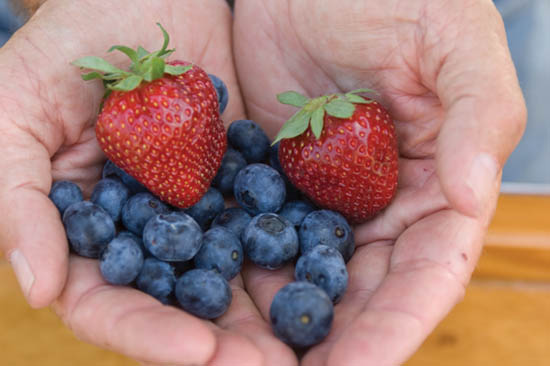
This connection can be found and sustained by shopping regularly at local farmers markets. Maybe thats why theyre growing so quickly in popularity. According to the USDA, in 2007 there were more than 4,500 farmers markets in the United States, nearly double the number of nationwide farmers markets that existed in 2000. Sales from these markets exceeded $1billion, most of which went back to the pockets of small farmers.

